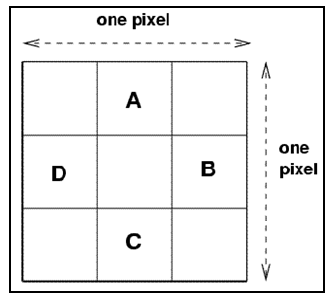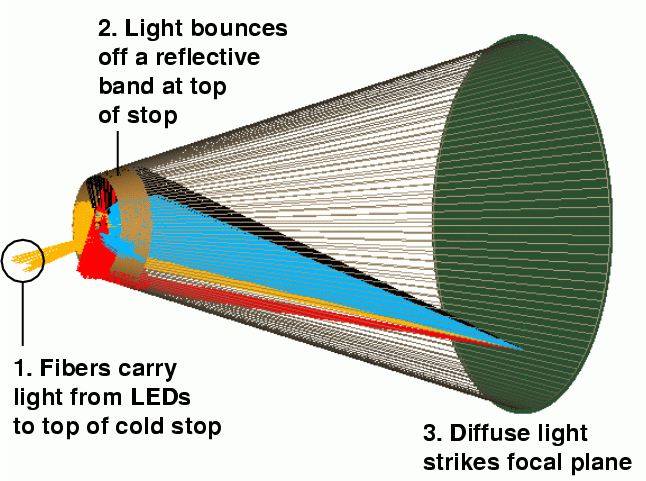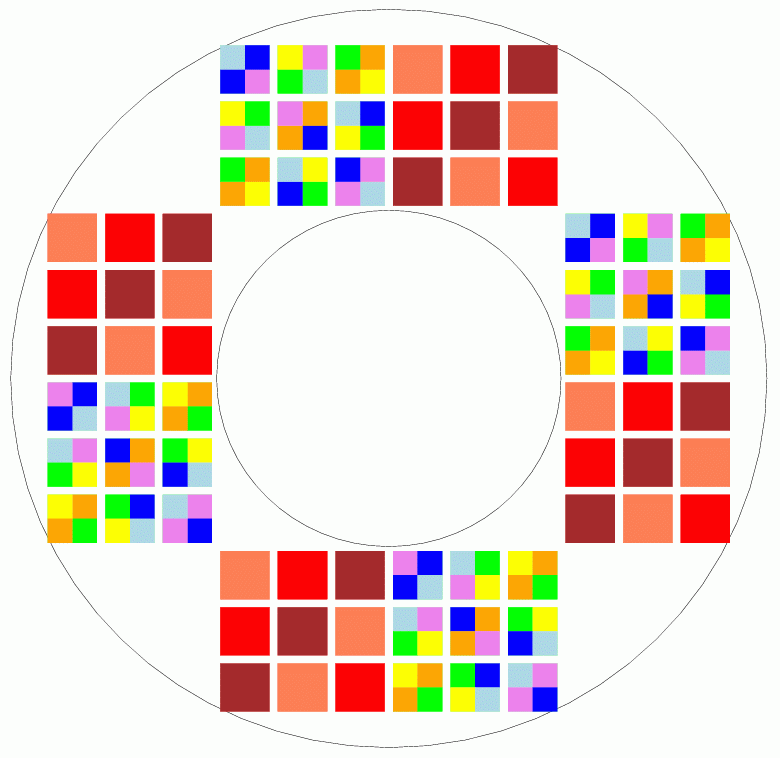
For this review, we define flatfielding to mean
corrections for any sort of systematic changes in photometry as a star moves across the focal plane
As we will see, this will include certain effects due to filters and stellar colors which are usually considered under different headings.
There are many different reasons for the apparent brightness of a star to change as it moves in the focal plane. Rather than organize this talk by the causes of such changes, I will break it up into groups based on the spatial scale of the changes:
Intra-pixel: within one pixel, subarcsecond

It is likely that the response of a single pixel will vary slightly depending on exactly where light strikes it: a pinpoint of light falling on the top of the chip, A , might yield more counts than the same source of light falling on the left side of the chip, D.
This variation will almost defintely depend on the wavelength of the light.
Solution: The baseline plan is to divide each image of the main SNAP field into 3 or 4 short exposures. We should "dither" the telescope on very small scales, fractions of a pixel, between the short exposures. If we can control the motions, we should try to move the telescope so stars shift by roughly 1/3 of a pixel per step (as shown in diagram above). If not, we take whatever motion we get. After processing the data initially, we can figure out the exact sub-pixel location of each star in each exposure. Over the course of ordinary operations, we will have samples of thousands of bright stars of different colors measured many times at different sub-pixel locations.
Inter-pixel: tens of pixels, few arcseconds
This sort of variation, from one pixel to its neighbors, is the type most people mean when they use the term "flatfielding."
This variation will almost defintely depend on the wavelength of the light.
Solution: We can address these variations in two ways.
First, we could arrange the ordinary mowing scans of the telescope so that stars in the SNAP field do not fall on exactly the same pixels each time, but shift by a few arcseconds. Over the course of the mission, this would provide a very large dataset from which we could derive corrections.
Second, we can use an internal source of light to flood the entire focal plane with a (nearly) uniform illumination. The Ring of Fire is one candidate.

Although there may be significant variations in illumination on large scales, an internal source should provide uniform light over regions tens of pixels (one millimeter) in size. We can set the exposure time to achieve very high signal-to-noise ratios and vary the wavelength of the light.
The illumination of the focal plane from the Ring of Fire will not be quite the same as the illumination from a point source at infinity viewed through the telescope optics. It is possible that one could achieve a more star-like illumination by sending light through an optical fiber to the top of the telescope tube and shining it down on the primary mirror.
Intra-chip: hundreds of pixels, few arcminutes
The internal light source(s) may not be perfectly uniform over larger scales, from one side of a chip to another: roughly 35 mm or 6 arcminutes. We can use the internal light source to derive first-order corrections on these scales, but it will not be sufficient.
To make the final corrections, we will rely upon stars as our light sources, following the "starflat" procedure. We can select subsamples as desired -- those with high signal-to-noise, within certain ranges of color, with known (low) levels of variability over time.
Solution: Take a special series of exposures during calibration operations. Slew the telescope so that stars move in a 4x4 or 5x5 grid across the chip. With exposures of 100 seconds or so, there will be a few tens of stars per chip. Make a simple model of photometric variation across the chip and use these measurements to solve for the appropriate parameters.
Inter-chip: neighboring chips, tens of arcminutes
There will certainly be differences in the gross sensitivity from one chip to the next, due to variations in the sensor itself and also small differences in the passbands of different filters of the same type. In simple terms, we must solve for the magnitude zeropoint of each device.
Note that in addition to the normal position-dependent errors, differences between individual filters of the same ostensible passband will lead to color-dependent errors. We must make sure that the fields chosen for the special calibration measurements below include a wide range of stellar colors.
Solution: During special calibration operations, shift the telescope so that stars move in a regular pattern from one chip to the next within a quadrant. Using the changes in apparent brightness to solve for the zeropoint of each device relative to its neighbors of the same type. We also must solve for color-dependent differences in the photometry.
In other words, set up a set of linear equations relating the (unknown) true magnitudes M of a set of stars to their measured magnitudes m
![]()

and solve for the parameters ai, bj, etc., belonging to the i-th chip and j-th filter.
Quadrant: across focal plane, degree
The SNAP focal plane is laid out in quadrants:

During normal operations, the telescope will "mow" a path across the sky which causes stars to slide across a single quadrant. We will therefore accumulate a great many measurements from which the relative sensitivity of chips within a single quadrant may be determined. However, systematic errors between sensors on opposite sides of the focal plane might remain undetected.
It is on this scale that we might expect to see variations in apparent brightness due two additional factors:
Note that, to some extent, simple radial variations on large scales will be removed by the intra-chip and inter-chip corrections derived for their own sakes.
Solution: We need two special sets of observations during calibration time. First, we must slew the telescope so that a set of stars moves to each of the four quadrants; it might or might not be necessary to ensure that a single object is placed on each of the detectors in each quadrant (since we may have independent measurements of the variations between sensors within a quadrant). Second, we must take a series of exposures of varying exposure times, from very short (less than one second) to very long (the typical 100-second length of a normal exposure).
For more information, see the chapter on Flatfielding from the Calibration Volumes: